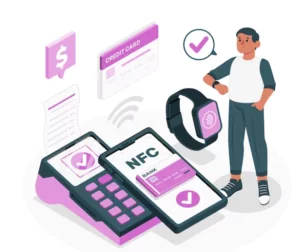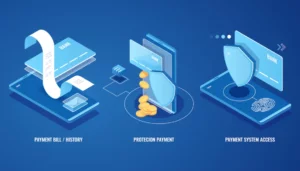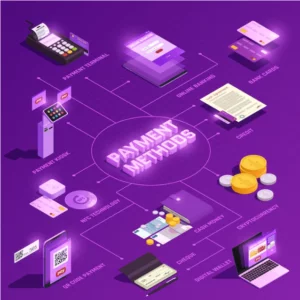The most stressful part of managing an online store is dealing with customers’ financial information. In addition to keeping the lights on, it also handles private information about your customers.
Benefits such as operational efficacy, client retention, improved sales, and more can accrue from settling on a payment processing system that works for you and your customers.
What Is Payment Processing In Ecommerce Stores?
When a company takes payments from clients via an online store, this is known as ecommerce payment processing. This is achieved through a payment gateway, which acts as a safe passageway for consumers’ financial data and payments as they are transferred from them to the retailer.
When making an online purchase, the consumer may assume that the payment process only takes a few seconds and involves only the merchant, the customer, the payment processor, the merchant account service, and the customer’s and merchant’s banks.
Payment processing for online purchases vs. more conventional methods

The standard method of processing payments for online purchases is for the retailer to incorporate a payment gateway provided by a separate company throughout the purchasing process.
The buyer is sent to a secure online payment form hosted by a third party, where they may input their payment information and finalize the transaction.
You may accept payments directly from customers via your company’s website, thanks to built-in e-commerce functionality.
It’s convenient for the client and builds confidence between the store and the buyer. Customers are less likely to finish an online purchase when diverted to a third-party site, increasing the likelihood that they will abandon the basket and go elsewhere to complete their purchase because of security concerns.
According to research conducted by the Baymard Institute, a think tank for e-commerce, 18% of customers would only complete a purchase if they trusted the site’s financial details.
How does the method of accepting payments online function?
When making an online purchase, the first step is often entering the customer’s credit card or debit card information into a secure form on your website or mobile app. Your payment gateway will transmit the customer’s encrypted card information to the processor.
Next, the processor contacts the customer’s issuing bank to verify whether or not there is adequate money in the account to cover purchase.
The authorization or refusal is relayed from the payment processor to the payment gateway, which notifies the online store. An order confirmation is sent to the consumer, typically in the form of an email receipt, if permission is granted.
The customer’s credit or bank account is automatically charged for the purchase amount, and the monies are transferred to the retailer’s account.
Participants in an Online Purchase

- Payment Processor: The term “payment processor” refers to any company in the financial services industry (such as a credit card services company) that helps enable online purchases. When a consumer makes a purchase, their financial institution or credit card provider sends their information to the payment processor, who then sends it to the merchant.
- Payment Gateway: The payment gateway is the software that facilitates communication between your online store and a merchant account provider. This makes it easier to information between the customer-facing website and the payment processor (and, by extension, the issuing and receiving banks). The payment gateway also communicates the authorization or refusal status to the online store.
- Merchant Account: Online retailers need a merchant bank account to accept credit card payments from clients. This happens once the customer’s payment has been authorized and settled, which means the monies have been placed into the merchant account from the customer’s credit or debit card institution. After one or two business days, the money is sent to the merchant’s bank account. Establishing a partnership with a merchant services provider is essential for businesses seeking a merchant account.
Factors To Consider Before Choosing An Ecommerce Payment Processor
When deciding on a provider for your online store, you should consider how safe your consumers will feel making purchases with them, how many payment options they will have, where your customers live, and how much it will cost you to use their service.

-
Security
A secure sockets layer (SSL) certificate is required for online payment processing. You may install an SSL certificate on your web server to protect your online communications and transactions. Secure Sockets Layer (SSL) certificates encrypt communications between a customer’s web browser and your company’s website, safeguarding sensitive data from eavesdroppers.
After installing an SSL certificate, check that your e-commerce payment provider follows PCI standards. To accept credit card payments online, businesses must adhere to PCI standards.
Credit card companies have made compliance mandatory to protect the integrity of credit card transactions processed by your business.
-
Permitting several different payment methods
Payment gateways that accept not just credit and debit cards but also PayPal, Venmo, and e-checks are your best bet for online sales.
-
Facilitating overseas transactions
You may not need a payment processor that supports international transactions if your company only sells within the United States. Choose a service that supports international transactions if you anticipate dealing with customers from other countries.
It is important that your payment gateway accepts debit and credit cards issued by a wide range of international banks and that customers can transact in the currency of their choice. The portal should also help understand and comply with different tax regulations.
-
Charges and Expenses
Three primary factors contribute to the overall price of employing a payment processor for online sales:
- Set-up costs. Processors will usually charge an initiation fee, free to $250.
- The monthly subscription fee generally fall between $10 and $50.
- Transaction fee: Processors will typically charge between 1% and 5% of each transaction on top of a flat fee, usually no more than 25¢.
-
Integrations
Plus, make sure all integrations have been noticed. Your preferred payment gateway should be able to communicate with other e-commerce platforms like QuickBooks. In many companies, accounting software is used to keep track of financial activities; thus, having the two systems work together may be helpful. Some provide Facebook Marketplace sales and payment monitoring.
Read a blog on world’s best payment processors.
Security Measures Implemented By Payment Processing Integration

Different payment processing gateways may have different security measures in place, but here are some common security measures used by payment processing gateways:
- Encryption: Payment processing gateways encrypt payment information during transmission and storage to prevent unauthorized access. Encryption algorithms may include Advanced Encryption Standard (AES) or Transport Layer Security (TLS).
- Tokenization: Sensitive payment information, such as credit card numbers, may be replaced with a unique token for processing transactions. This helps to protect payment information in case of a data breach.
- Address Verification Service (AVS): Payment processing gateways may use AVS to verify the billing address provided by the customer with the address on file with the credit card company.
- Card Verification Value (CVV): Payment processing gateways may require customers to provide the CVV code on their credit card to verify its authenticity.
- Fraud detection: Payment processing gateways may use machine learning and other techniques to detect and prevent fraudulent transactions.
- 3D Secure: Some payment processing gateways support 3D Secure, a protocol that adds a layer of authentication to online transactions.
- PCI compliance: Payment processing gateways must comply with Payment Card Industry Data Security Standard (PCI DSS), which sets security requirements for processing, storing, and transmitting payment information.
- Two-factor authentication: Some payment processing gateways may offer two-factor authentication to prevent unauthorized access to accounts.
- IP filtering: Payment processing gateways may allow merchants to restrict access to their payment gateway to specific IP addresses.
- HTTPS protocol: Payment processing gateways typically use HTTPS protocol to encrypt all communication between the merchant’s website and the payment gateway.
Merchants must choose a payment processing gateway with robust security features and PCI-compliant. Additionally, merchants should follow best practices for ecommerce security, such as using strong passwords, regularly updating software, and implementing security protocols like HTTPS.
Process Of Ecommerce Payment Processing

E-commerce payment processing involves the steps required to securely and reliably process electronic payments for purchases made through an online store. In this process, payment information is transferred between the customer, the payment gateway, the acquiring bank, and the customer’s bank to authorize or decline the transaction. Let’s go through each step in more detail.
Step 1: Customer places an order and selects a payment method The customer selects the desired products and adds them to the shopping cart. Once the customer is ready to make a payment, they checkout and select a payment method. This could be a credit card, PayPal, or any other payment method the merchant accepts.
Step 2: Payment information is securely transmitted to the payment gateway When the customer enters their payment details, the payment information is securely transmitted to the payment gateway, which acts as a middleman between the merchant and the acquiring bank. The payment gateway is responsible for encrypting the payment information to ensure its security and transmitting the information to the acquiring bank.
Step 3: Payment gateway checks the payment details and transmits them to the acquiring bank The payment gateway checks the payment information for errors and fraudulent activity. If there are no issues, the payment gateway transmits the payment info to the acquiring bank. The acquiring bank is the financial institution that processes the payment on behalf of the merchant. The payment gateway uses a secure connection to transfer the payment information to the acquiring bank.
Step 4: Acquiring bank checks the payment details and routes the payment to the customer’s bank The acquiring bank checks the payment details for accuracy and sends the payment request to the customer’s bank. The customer’s bank is responsible for approving or declining the payment request. The customer’s bank will also check to ensure sufficient funds are in the customer’s account to cover the cost of the transaction.
Step 5: Customer’s bank approves or declines the transaction The customer’s bank will review the payment request and either approve or decline the transaction. The bank will approve the transaction if sufficient funds are in the customer’s account and the payment details are accurate. If there are any issues with the payment details or insufficient funds in the customer’s account, the bank will decline the transaction.
Step 6: Response is sent back through the acquiring bank to the payment gateway The acquiring bank will send the response back to the payment gateway. The response will indicate whether the transaction was approved or declined. The payment gateway will then forward the response to the merchant.
Step 7: Payment gateway communicates the approval or decline to the e-commerce platform. The payment gateway will communicate the response from the acquiring bank to the e-commerce platform. The platform will update the customer on the status of the transaction and will either process the order if the transaction was approved or ask the customer to try a different payment method if the transaction was declined.
Step 8: Acquiring the bank settles the funds from the transaction to the merchant’s account. If the transaction is approved, acquiring bank will settle the funds from the transaction to the merchant’s account. Settling funds can take a few days, depending on the merchant’s bank and the acquiring bank.
Conclusion
Ecommerce payment processing involves multiple steps that must be completed accurately and securely to ensure a smooth transaction for the customer and the merchant. Merchants need to choose a reliable payment gateway and acquiring bank to ensure that their customers’ payment information is secure and that transactions are processed efficiently.
FAQs
What is an ecommerce payment processing platform?
An ecommerce payment processing platform is a software or service that enables merchants to accept and process payments for online transactions.
What payment methods do ecommerce payment processing platforms typically support?
Ecommerce payment processing platforms typically support a range of payment methods, including credit and debit cards, bank transfers, digital wallets, and alternative payment methods like PayPal or Alipay.
What fees are associated with using an ecommerce payment processing platform?
Ecommerce payment processing platforms typically charge a fee for each transaction, which can be flat rate/ percentage of the transaction amount. Some platforms may also charge additional fees, such as setup fees or monthly subscription fees.
What security measures are in place to protect payment information processed by ecommerce payment processing platforms?
Ecommerce payment processing platforms typically use a range of security measures, including encryption, tokenization, and fraud detection systems, to protect payment information and prevent unauthorized access.
Can ecommerce payment processing platforms integrate with other ecommerce tools?
Yes, many ecommerce payment processing platforms offer integrations with a range of ecommerce tools, such as shopping cart software, inventory management systems, and accounting software.
How long does it typically take to set up an ecommerce payment processing platform?
The setup process for an ecommerce payment processing platform can vary depending on the platform and the merchant’s specific needs. Some platforms offer quick and easy setup processes, while others may require more time and effort to set up and integrate with other systems.
Can merchants customize the look and feel of their payment pages with ecommerce payment processing platforms?
Yes, many ecommerce payment processing platforms offer customization options for payment pages, allowing merchants to add their branding and create a consistent user experience for customers.



